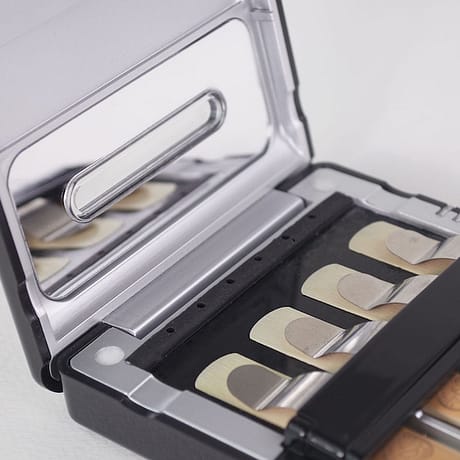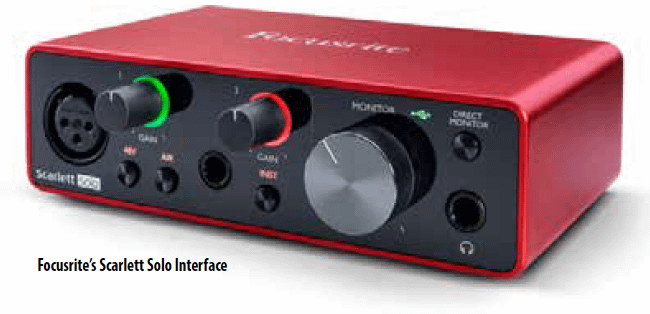-

A Guide To Computer Audio Interfaces
SBO Staff | February 12, 2021Whether you want to up your online audio presentation quality or increase your recording capabilities, this guide will help you choose from the confusing maze of choices. Read More... -
Let’s Throw a Little Light on the Subject
Bobby Owsinski | February 6, 2021We’ve gone over how to make your audio shine on your Zoom presentations, now let’s talk about the visual side for a bit. Although most people on a Zoom/Skype/Teams/etc. call don’t have to worry so much about how they look, it’s different for a teacher. You need your students to see you clearly so you […] Read More... -
A Guide To Computer Audio Interfaces
Mike Lawson | January 8, 2021
Read More...Getting audio into and out of a computer can be confusing – not necessarily because of the actual process or software used, but because there are so many choices when it comes to actually picking an interface before you get started.
-
The Right Signal Level for Every Situation
Mike Lawson | December 3, 2020
Read More...A fundamental of clean audio is setting the right level so there are no overloads. It seems like such an easy concept to those of us who’ve been recording for a while, yet until you get the hang of it, there’s most always some confusion about what works and what doesn’t. Hopefully you’ll never have to think about it again after reading this column today.
-
The Magic High-Pass Filter
SBO Staff | November 30, 2020A closer look at one of the most understated and overlooked controls in all of audio. Read More... -
The Magic High-Pass Filter
Mike Lawson | October 28, 2020
Read More...If you recently purchased a USB microphone, or almost any mic for that matter, you might notice the little “broken leg” symbol somewhere on the body. This is the switch for the powerful high-pass filter, one of the most understated and overlooked controls in all of audio.
-
Warning: Trying to access array offset on value of type bool in /home/sbomagazine/public_html/site/wp-content/themes/timeless2021/functions.php on line 437
Warning: Trying to access array offset on value of type bool in /home/sbomagazine/public_html/site/wp-content/themes/timeless2021/functions.php on line 438
Prepare Your Students for Your Online Class
SBO Staff | October 21, 2020It’s all well and good that you’re expertly prepared for your online session, but what about your students? Read More... -
Prepare Your Students For Your Online Class
Mike Lawson | October 1, 2020
Read More...It’s all well and good that you’re expertly prepared for your online session, but what about your students? There’s nothing worse than having someone (student or otherwise) disrupt a session because they can’t connect, can’t get their audio or video going, or has intermittent bandwidth.
-
Your Online Class Doesn’t Have To Be Boring
Mike Lawson | September 2, 2020
Read More...Now that school is back in session, you’re probably in unfamiliar territory having to teach remotely. Whether you’re using Zoom, Teams, Meet, Webex, or any other videoconferencing app, there’s a way to do it where you’re at your most engaging.
-
Warning: Trying to access array offset on value of type bool in /home/sbomagazine/public_html/site/wp-content/themes/timeless2021/functions.php on line 437
Warning: Trying to access array offset on value of type bool in /home/sbomagazine/public_html/site/wp-content/themes/timeless2021/functions.php on line 438
Get A Big Teleconference Voice With Just A Tiny Mic Tweak
SBO Staff | August 19, 2020Has anyone ever said, “Wow, you sound great!” after your first words? Read More... -
Get A Big Teleconference Voice With Just A Tiny Mic Tweak
Mike Lawson | July 31, 2020
Read More...Now that you have your fancy new USB microphone and you’ve been doing conferences via Zoom, Skype, Teams or any other of the popular streaming apps, has anyone ever said, “Wow, you sound great!” after your first words? If not, you may not be getting everything from the mic that you can, but the fix can be easier than you think.
-
Optimizing Your Online Meeting Audio Stream
Mike Lawson | July 15, 2020
Read More...Thanks to the times we live in, we’re all doing a lot more online conferencing these days. Whether it be on Zoom, Skype, Teams, or Meet, the need to be heard clearly and with fidelity is greater than ever before.
Warning: Undefined variable $additional_loop in /home/sbomagazine/public_html/site/wp-content/themes/timeless2021/archive.php on line 103
Warning: Attempt to read property "max_num_pages" on null in /home/sbomagazine/public_html/site/wp-content/themes/timeless2021/archive.php on line 103




 Getting audio into and out of a computer can be confusing – not necessarily because of the actual process or software used, but because there are so many choices when it comes to actually picking an interface before you get started.
Getting audio into and out of a computer can be confusing – not necessarily because of the actual process or software used, but because there are so many choices when it comes to actually picking an interface before you get started.
 A fundamental of clean audio is setting the right level so there are no overloads. It seems like such an easy concept to those of us who’ve been recording for a while, yet until you get the hang of it, there’s most always some confusion about what works and what doesn’t. Hopefully you’ll never have to think about it again after reading this column today.
A fundamental of clean audio is setting the right level so there are no overloads. It seems like such an easy concept to those of us who’ve been recording for a while, yet until you get the hang of it, there’s most always some confusion about what works and what doesn’t. Hopefully you’ll never have to think about it again after reading this column today.

 If you recently purchased a USB microphone, or almost any mic for that matter, you might notice the little “broken leg” symbol somewhere on the body. This is the switch for the powerful high-pass filter, one of the most understated and overlooked controls in all of audio.
If you recently purchased a USB microphone, or almost any mic for that matter, you might notice the little “broken leg” symbol somewhere on the body. This is the switch for the powerful high-pass filter, one of the most understated and overlooked controls in all of audio.
 It’s all well and good that you’re expertly prepared for your online session, but what about your students? There’s nothing worse than having someone (student or otherwise) disrupt a session because they can’t connect, can’t get their audio or video going, or has intermittent bandwidth.
It’s all well and good that you’re expertly prepared for your online session, but what about your students? There’s nothing worse than having someone (student or otherwise) disrupt a session because they can’t connect, can’t get their audio or video going, or has intermittent bandwidth.
 Now that school is back in session, you’re probably in unfamiliar territory having to teach remotely. Whether you’re using Zoom, Teams, Meet, Webex, or any other videoconferencing app, there’s a way to do it where you’re at your most engaging.
Now that school is back in session, you’re probably in unfamiliar territory having to teach remotely. Whether you’re using Zoom, Teams, Meet, Webex, or any other videoconferencing app, there’s a way to do it where you’re at your most engaging.
 Now that you have your fancy new USB microphone and you’ve been doing conferences via Zoom, Skype, Teams or any other of the popular streaming apps, has anyone ever said, “Wow, you sound great!” after your first words? If not, you may not be getting everything from the mic that you can, but the fix can be easier than you think.
Now that you have your fancy new USB microphone and you’ve been doing conferences via Zoom, Skype, Teams or any other of the popular streaming apps, has anyone ever said, “Wow, you sound great!” after your first words? If not, you may not be getting everything from the mic that you can, but the fix can be easier than you think.
 Thanks to the times we live in, we’re all doing a lot more online conferencing these days. Whether it be on Zoom, Skype, Teams, or Meet, the need to be heard clearly and with fidelity is greater than ever before.
Thanks to the times we live in, we’re all doing a lot more online conferencing these days. Whether it be on Zoom, Skype, Teams, or Meet, the need to be heard clearly and with fidelity is greater than ever before.





